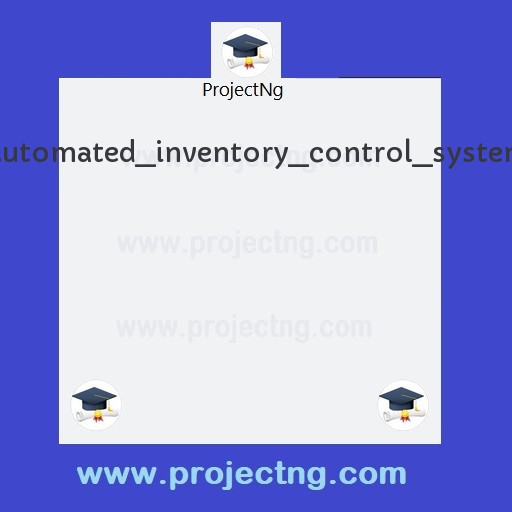Design and implementation of an automated inventory control system for a manufacturing organization
Computer Engineering Project Topics
Get the Complete Project Materials Now! »
DESIGN_AND_IMPLEMENTATION_OF_AN_AUTOMATED_INVENTORY_CONTROL_SYSTEM_FOR_A_MANUFACTURING_ORGANIZATION
CHAPTER ONE
1.0 INTRODUCTION
An inventory control system contains a list of orders to be filled and then prompts workers to pick the necessary items, and provides them with packaging and shaping information, inventory control may be used to automate a sales order fulfillment process and also manage in and outward material of hardware. Automation is the replacement of human workers by technology. For optional sales and inventory management process, robust functionality is needed for managing logistic facilities. Ware house management functions for inventory control cover internal ware house movements and storage and its support helps in the recording and tracking of materials on basis of both quantity and value.
This application takes care of all supply orders reducing cost for warehousing, transportation while improving customer service. It significantly improves inventory turns, optimizes flow of goods and shortens routes within warehouse and distribution centres. it also improves cash flow, visibility and decision making providing efficient execution of task using this fast and reliable computerised method.
1.1 HISTORICAL BACKGROUND OF THE STUDY
The Petroleum Equalisation Fund Management Board is a scheduled Parastatal of the Ministry of Petroleum Resources ,established by Decree No.9 of 1975 (as amended by Decree No. 32 of 1989 ), mainly to administer Uniform Prices of Petroleum products through out the country . This is achieved by reimbursing a marketer’s transportation differentials for petroleum products movement from depots to their sales outlets (filling station), in order to ensure that products are sold at uniform pump price throughout the country. The source of the Fund is from principally the net surplus revenue recovered from Oil Marketing Companies.
It has an Operational Office in Lagos, five (5) Zonal Offices as well as twenty-two (22) Depot Offices located at the 21 NNPC Depots and Marketers’ storage facilities at Apapa and Ibafon. It is headed by the Executive Secretary who is the Chief Administrative Officer, responsible for the day to day operations of the fund.
2
In 1979, Government, conscious of the fact that petroleum products supply did not reach the remotest parts of the country encouraged Major Marketers to open filling stations in those areas.
The purpose of this Charter is to explain what we do, how we provide effective and efficient services and our commitment to all Stakeholders and customers. It also welcomes feedback as a means of assessing our performance and meeting expectations.
(a) Mission Statement
The Management and Staff of the Petroleum Equalisation Fund (Management) Board are pleased to present our Service Delivery Charter. There shall, be, for the purpose of administering the fund in accordance with the provisions of this Act, a body to be known as the Petroleum Equalization Fund Management Board (hereafter in this Act referred to as the ―the fund‖).
The legislative Charter of the Board as provided by Decree No.9 of 1975 as amended by Decree No. 32 of 1989 (now Chapter 352) of the Laws of the Federation 1990)
The Petroleum Equalisation Fund (management) Board is committed to equalize the transportation differentials in white products marketing and a Uniform Prices of Petroleum Products obtains in the country and stakeholders are promptly and fairly treated in the process.
The PEF(M)B as a good corporate organization would strive to dutifully implement all government directives, especially in ensuring transparency, probity and accountability. It would collaborate with all Stakeholders in ensuring prompt settlement of Marketers claims to enhance the distribution of petroleum products to make them available at reasonable costs nation-wide.
In addition to its primary functions, the Board would, with its new computerization structure, strive to build a data/information bank for accurate data on the level of lifting and distribution of petroleum products throughout the federation
(b) Vision
To become an efficient, technology-driven, stakeholder-oriented and pro-active partner in facilitating the transportation and distribution of Petroleum Products nation-wide by the year 2020 .The Petroleum Equalisation Fund (Management) Board values and promotes high ethical standards of a responsible public service organization, and it’s specifically committed to: Transparency, Efficiency, Responsiveness and Integrity.
3
© Service Provision and Delivery
What We Do: In broad terms, the Board performs two (2) basic functions, namely:
( i ) The Administration of price equalization scheme to ensure the sustenance of
Government Policy of Uniform Pump Prices for petroleum products nation- wide;
( ii ) The administration of bridging payment scheme to complement the Nigeria National Petroleum Companies pipeline distribution network of petroleum products to all the depot areas nation-wide, during breakdown/maintenance of local refineries and or pipeline breaks/vandalisation.
(d) The Equalisation Scheme:
I. The consumer pays the in – build transportation cost of N2.30kobo per litre irrespective of where the product is purchased. The amount is not static because of government policy.
II. Transportation cost is related in distance traveled between the points of lifting the products (Depots) and the points of sale (filling stations)
III. The marketer serves as an agent of the PEF (M) B in collecting the allowances build – into the price structure, and transfers same to the Board for equalization or bridging purposes. The allowance collected for bridging is N1.87Kobo. This also changes from time to time.
Be the First to Share On Social

Enjoying our content?
Don't miss out on new videos! Subscribe to our YouTube channel for more awesome content.
Subscribe Now!













